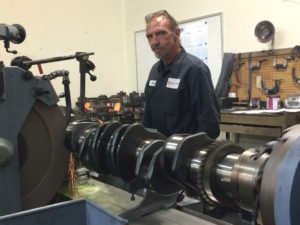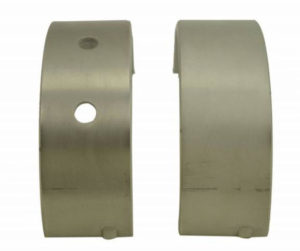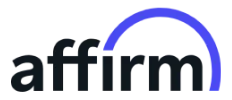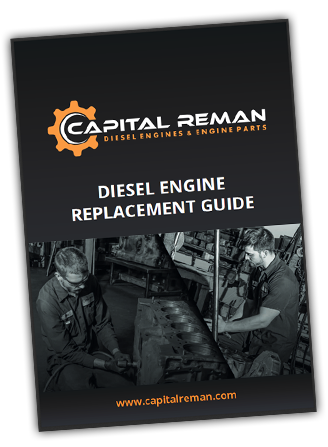What is Crankshaft Grinding?
 Crankshaft Grinding at Capital Reman
Crankshaft Grinding at Capital Reman
We here at Capital Reman are experts at grinding and remanufacturing diesel crankshafts. Crankshaft grinding consists of removing a minute amount of finished material from the rod and main journals to rebuild the part back to OEM spec. The full 25 step crankshaft remanufacturing process is quite intensive but is critical to complete engine rebuild. This article will explain the main components of a crankshaft’s design as well as the finer points of crankshaft remanufacturing.
A crankshaft consists of rod and main journals. These journals are the end bearings at the bottom of the connecting rods opposite the pistons. The journals (also called crankpins) are connected to counterweights via plates called the webbing. These counterweights help balance the load of the crankshaft when in motion. There is also the crankshaft nose which connects to a pulley or vibration damper. The rods and mains have oil galleries embedded in them to allow oil flow throughout the crankshaft. It is important that the bearing holes are lined up properly to allow oil flow. The back end of the crankshaft is connected to the flywheel.
The main reason crankshaft grinding is done is because the crank wears over time. Over thousands miles the end play between the crankshaft and the bearings increases. When the “fit” between the bearings and the crank isn’t perfect it lowers oil pressure and decreases lubricity. The less oil to the crank the faster it can wear out. When you reduce the size of the bearings you reduce the overall surface area too. Less surface area equals less friction and better engine performance. Also, when you grind a crankshaft the journals end up having a greater radius which by reducing stress at the corners. Engine performance with a reground crankshaft can be quite noticeable when on an engine dyno. Performance crankshafts can be lightened by drilling the pins but mostly when you talk about performance parts you are referring to the camshaft. Overall, the vast majority of crankshaft issues revolve around the bearings. Crankshaft Bearings
Crankshaft Bearings
During the remanufacturing process the machinist is mostly concerned with grinding the rod and main journals. Upon initial inspection of the crankshaft, with the use of the micrometer, the machinist will determine what bearings need grinding. Indicators that a journal needs grinding include if the surface has wear and make it rough to the touch. Sometimes the journal will be knocked out of center and needs to be surfaced to round and straightened. Consequently, the journal diameter could be positioned out of square at both end of the pins. Each grind is different but all crankshafts can be ground to allow for more or less stroke depending on customer needs.
When the machinist has decided to remanufacture the crankshaft he will grind the top layer of the journal away to make the surface smooth. The amount taken off is determined by looking at what OEM spec is and then seeing how badly the journal is worn. Typical amounts removed are (Standard) 0.005”, 0.010”, 0.020” and 0.030”. A crank can be ground to as much as 0.050" as this is the biggest bearing sizes the OEM makes. The crankshaft is loaded onto the machine and then positioned using a hand-wheel which controls the manual micrometer wheel-head infeed. When the size is determined the machinist will set the indexed ring to 0 and keep the hand-wheel at 0 position. Then the machinist turns a locking knob to engage the device. Before the machinist is ready to begin grinding he then takes into account a safety allowance for any tuning errors. There are 5 different safety allowance positions: .02”- .06”. Once the safety tolerance has been recorded the machinist will engage the wheelhead back with a lever and the micrometer infeed handwheel will turn counterclockwise with the same amount of preset as the stop knobs. Ginding can now being. The machinist will manually advance the wheelhead to the ground journal until it has completed the journey around the spinning crankshaft. It is imperative that the machinist watch the speed of the handwheel and adjust it with the width of the journal. A work preset knob allows for quick stock compensation from journal to journal and allows the machinist to jump to a new journal without having to reset the specifications. Diesel Crankshaft Diagram
Diesel Crankshaft Diagram
After the crankshaft is ground to the appropriate size it is then polished. The journals are polished using a piece of emery paper or polishing belts. Polishing the journals prevents any sort of rough finish for the bearings to catch on. To polish the crankshaft the crank is spun in a counterclockwise fashion and the paper is manually placed on the journals while spinning. The journals become extremely smooth which reduces resistance and improves overall engine power and torque ratings. It should be noted that polishing the crankshaft is taken into account during the grinding process. The finished polish takes off just a little bit more material on top of the grind to the exact OEM spec.
Once the grind has taken place there is going to be quite a bit of excess clearance. The clearance is simply too much and must be brought back to factory tolerances. This is accomplished by installing undersized or oversized bearings because by grinding the new journal size is smaller. The bearings used should match the proper OEM clearances for oil flow at the diameter of the journal.
Some crankshaft rebuilders will undercut the crankshaft. Undercutting the crankshaft journals and then welding them back up will strengthen the crankshaft. Some cranks are unsuitable for grinding because they are well below OEM tolerances. In this instance you can scrap the crankshaft or decide to weld. The welding buildup includes a thermal spray and a stress relief process under extreme heat. All crankshaft will also be checked for straight. If the crankshaft is not centered the machinist will heat the crank and use a Gleason Welding and Straightening machine and re-position the crankshaft. Once the crankshaft is ground, polished and straightened it is checked for hardness via the Rockwell Hardness Scale. If the crankshaft is shipping to a humid climate it is coated in Cosmoline which is a rust proofing agent.
Crankshaft grinding is a methodical yet important part of engine remanufacutring. Today, CNC machinery can grinding and polish a crankshaft in a matter of minutes however doing it the manual way provides room for performance upgrades and a keen eye for overall strength of the crank.




